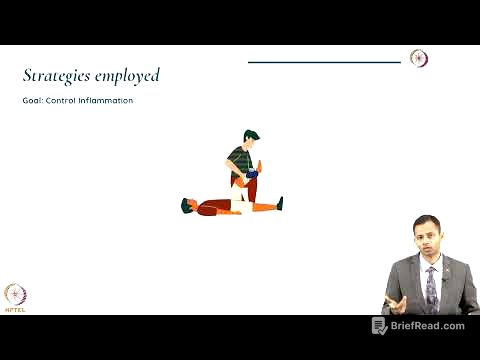TLDR;
This video features a discussion with Dr. Bill Campbell, a leading fat loss researcher, focusing on the concept of high energy flux for effective and sustainable weight management. They discuss the importance of eating more and moving more, the nuances of spot reduction, the role of resistance training versus cardio, and the critical need to preserve muscle mass during weight loss to avoid rebound weight gain. The conversation also touches on practical strategies for reversing restrictive diets and the impact of GLP-1 receptor agonists on dietary habits.
- High energy flux (eating more and moving more) can lead to better long-term weight loss outcomes compared to low energy flux (eating less and moving less).
- Spot reduction might be possible to a negligible degree, but overall fat loss strategies should focus on larger, more impactful approaches.
- Resistance training is crucial for preserving muscle mass during weight loss, which is essential for long-term weight management.
- Reintroducing calories after a restrictive diet should be done strategically to avoid rapid weight regain, with a focus on preserving lean tissue.
Intro [0:00]
The video introduces Dr. Bill Campbell, a prominent fat loss researcher, to discuss unconventional approaches to fat loss, particularly the concept of high energy flux. The conversation aims to explore how eating more and moving more can paradoxically lead to better fat loss outcomes.
Free Sample Flavors Pack of LMNT [3:30]
Thomas promotes LMNT Electrolytes, highlighting their sparkling electrolyte cans as a tasty, soda-like alternative for those in a caloric deficit or aiming to build muscle while staying lean. He mentions the product's composition of 1,000mg sodium, 200mg potassium, and 60mg magnesium, making it fasting-friendly. A link in the description offers a free sample variety pack with any purchase, featuring flavours like citrus salt, watermelon salt, and grapefruit salt.
Better Body Composition in High Energy Flux People vs Low [4:42]
Dr. Campbell introduces the concept of high energy flux, contrasting it with the more common low energy flux state. He explains that individuals in a low energy flux state typically consume few calories and have low physical activity, while those in a high energy flux state eat a lot and move a lot. The general population often struggles with low-calorie diets due to the abundance of ultra-processed foods, leading to overeating. Shifting to a high energy flux mindset can result in better long-term weight loss outcomes.
NEAT [9:10]
The discussion shifts to non-exercise activity thermogenesis (NEAT), referring to the energy expended for activities other than structured exercise. Thomas suggests that NEAT could be a significant factor in energy expenditure, even more so than deliberate exercise. Dr. Campbell agrees, noting that individuals in a low energy state are more likely to conserve energy in daily activities, while those who are fit tend to be more active and less concerned about expending extra energy.
High Energy Flux State [10:56]
The benefits of a high energy flux approach are discussed, particularly its inclusion of cardio. Dr. Campbell notes that while some in the fitness community view cardio negatively, a high energy flux lifestyle embraces it. Thomas adds that having more energy on board psychologically makes people more inclined towards physical activity. Dr. Campbell shares a personal anecdote about incorporating more conditioning work into his routine, highlighting the psychological and physical benefits of increased activity.
Spot Reduction [14:23]
The conversation addresses the possibility of spot reduction, where fat is lost in specific areas of the body. Dr. Campbell admits his opinion has evolved, acknowledging some research suggests it might be possible, although not necessarily likely. He mentions studies showing spot reduction with resistance training followed by aerobic activity. Thomas agrees that while it might be negligible, it's not a complete moot point, especially for those already relatively lean.
Why Some People Have More Fat in Certain Areas Than Others [16:59]
Thomas introduces the theory behind stubborn fat loss, explaining the roles of alpha and beta adeneric receptors in fat cells. Beta receptors promote lipolysis (fat breakdown), while alpha receptors inhibit it. Stubborn fat areas have a higher density of alpha receptors. Yohimbine, an alpha adeneric receptor antagonist, is mentioned as a potential aid, although not generally recommended due to its risk profile. Genetic predisposition is believed to influence the density of these receptors.
Cardio vs Resistance Training for Short-Term Fat Loss [22:05]
The discussion compares cardio and resistance training for short-term fat loss. Dr. Campbell references Dr. Mike Ormsby's work, which indicates resistance training elevates lipolysis and beta oxidation (fat burning) for a significant period post-workout. He explains the two main steps of fat loss: lipolysis (breaking down fat) and oxidation (burning fat). While cardio burns more calories in the short term, resistance training has unique benefits for fat loss by stimulating both lipolysis and oxidation.
Glycerol [27:47]
Thomas asks about the fate of glycerol, the backbone of triglycerides, during lipolysis. Dr. Campbell explains that glycerol levels in the blood are a marker of lipolysis. Glycerol can be converted into glucose, especially in a low-calorie state. The conversation touches on the use of glycerol as a pump agent by bodybuilders and for hyperhydration in endurance events, questioning whether this might impede fat oxidation.
How to Bring Calories Back Up After Losing Weight (reverse dieting) [31:42]
The conversation shifts to strategies for reintroducing calories after a period of calorie restriction, known as reverse dieting. Dr. Campbell shares details of an ongoing study in his lab, which is investigating different approaches to reverse dieting. The study involves participants losing 5% of their body weight and then being randomised into groups with either a slow increase in calories, an immediate increase based on an NIH equation, or a control group with no rules.
Why Muscle Is So Important for Long-Term Weight Loss Success [39:57]
Dr. Campbell emphasises the importance of preserving muscle mass during weight loss for long-term success. He references the Minnesota starvation experiment, which showed that hyperphasia (extreme hunger) persisted until subjects regained their lost lean mass, leading to fat overshoot. He highlights that diets causing muscle loss are detrimental to long-term weight management. The discussion also touches on the potential for fitness professionals to help people maintain muscle during weight loss.
Where to Find More of Dr. Campbell [48:52]
Dr. Campbell shares his Instagram handle, Bill Campbell PhD, and his YouTube channel, also named Bill Campbell PhD, as the best places to find his work.









